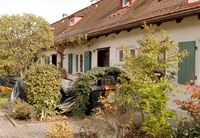Workers' settlements
Eiernest and Kolonie Südheim
"Eiernest" takes its name from the area of the same name on the edge of Heslach. The settlement stretches along Eierstrasse, Liebigstrasse and Schreiberstrasse. In 1926, the 180 single-storey detached houses were built as part of a social housing program of the city of Stuttgart for municipal workers and employees. Based on the English garden city idea, the complex is one of Stuttgart's best-preserved workers' housing estates. Bordered by densely wooded slopes, the Eiernest remains a small idyll on the outskirts of the city to this day.
The settlement project "Kolonie Südheim" was developed between 1902 and 1904 and is closely linked to the history of social reform building projects. The "Verein zum Wohl der arbeitenden Klasse" (Association for the Welfare of the Working Class), chaired by Eduard Pfeiffer, was privately financed and aimed to improve the poor housing situation of workers at the time.
It was never completed and the few houses still bear witness to an interesting architectural concept. As is typical of Stuttgart housing estates at the turn of the century, Südheim features a combination of exposed brick and rendered surfaces as well as the use of historicizing stylistic elements: Half-timbered construction and architectural sculptural decoration. After the redesign of Südheimer Platz, the Südheim estate has also become more attractive.









